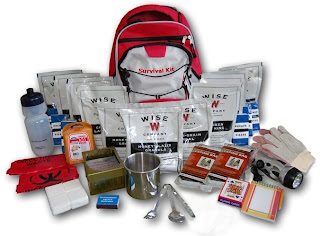This Long Term Food Storage Essentials Kit has all of the food and supplies you will need to keep you safe for an extended period of time. There are 44 Long Term Food Storage Meals in this kit that will feed 1 Person for 14 days or 2 People for 1 Week. It is all packaged in our large Hikers Backpack.
This kit contains the following:
Food and Water: The food and water in this kit will comfortably provide you with adequate nutrition for 72-hours without access to additional supplies. These products have a 5 year shelf life.
11 Cook in the Pouch Meals with a total of 44 meals:
• 28 - Lunch/Dinner Servings
o Stroganoff - 4 Servings (1 Pouch)
o Creamy Chicken Pasty - 4 Servings (1 Pouch)
o Cheesy Lasagna - 4 Servings (1 Pouch)
o Chicken Teriyaki - 4 Servings (1 Pouch)
o Chicken Ala King - 4 Servings (1 Pouch)
o Southwest Bean & Rice (1 Pouch)
o Beef Teriyaki - 4 Servings (1 Pouch)
• 16 - Breakfast Servings
o Honey Glazed Granola - 8 Servings (2 Pouches)
o Multi-Grain Cereal - 4 Servings (1 Pouch)
o Brown Sugar Oatmeal - 4 Servings (1 Pouch)
24 oz. Water Filtration bottle
Light and Communications:In the event of a power outage caused by you’ll have independent access to your own means of lighting and communication with the outside world.
Dynamo 4-in-1 Radio Flashlight
Waterproof Matches
Shelter and Warmth:These supplies will provide protection from outside weather forces. They will protect you from wind, sun, rain, and many other conditions you may encounter.
2 Mylar Emergency Sleeping Bags
Tools:These items are designed to be useful in disaster situations. They will be a valuable resource when you find yourself faced with navigation, transport, personal protection, or shelter troubles.
Portable Cooking Stove (includes 8 Fuel Tablets)
Steel Fork, Knife, & Spoon Chow Kit
16 oz Steel Cup
Pair of Leather Palm Work Gloves
2 Infectious Waste Bags
Hygiene and Sanitation: When in a disaster situation it is useful to have access to hygiene products. Staying clean can protect against infection, disease, and depression.
3 Packs of Pocket Tissues
First Aid: These first aid items can assist with minor injuries and protect against serious health concerns in disaster circumstances.
37 Piece Pocket First Aid Kit
Other: These items are useful for stress relief and activity in strenuous or challenging circumstances.
Deck of Standard Playing Cards
Note Pad
Golf Pencil
Emergency Survival Kit Information:
This Long Term Food Storage Essentials Survival Kit was designed using advice from experts in the emergency preparedness industry. It follows guidelines given by government agencies and non-profit preparedness organizations. This survival kit has a retail value of $250 but you can order now through Providence Safe Rooms for
$170.00 with Free Shipping Preparedness is Keywww.ProvidenceSafeRooms.com










